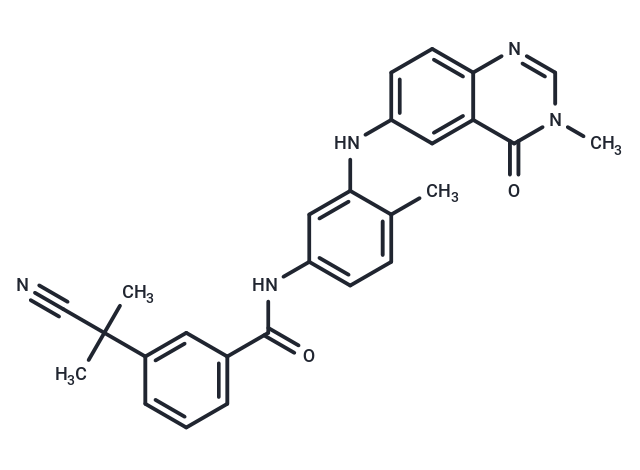Shopping Cart
- Remove All
 Your shopping cart is currently empty
Your shopping cart is currently empty

AZ628 is a new pan-Raf inhibitor for BRAF, BRAFV600E, and c-Raf-1 with IC50 of 105 nM, 34 nM and 29 nM, also inhibits VEGFR2, DDR2, Lyn, Flt1, FMS, etc.

| Pack Size | Price | Availability | Quantity |
|---|---|---|---|
| 2 mg | $38 | In Stock | |
| 5 mg | $61 | In Stock | |
| 10 mg | $93 | In Stock | |
| 25 mg | $182 | In Stock | |
| 50 mg | $288 | In Stock | |
| 100 mg | $373 | In Stock | |
| 1 mL x 10 mM (in DMSO) | $61 | In Stock |
| Description | AZ628 is a new pan-Raf inhibitor for BRAF, BRAFV600E, and c-Raf-1 with IC50 of 105 nM, 34 nM and 29 nM, also inhibits VEGFR2, DDR2, Lyn, Flt1, FMS, etc. |
| Targets&IC50 | B-Raf (V600E):34 nM, BRAF:105 nM, C-Raf1:29 nM |
| In vitro | AZ628 prevents activation of number of tyrosine protein kinases including VEGFR2, DDR2, Lyn, Flt1, FMS and others. AZ628 suppresses anchorage-dependent and -independent growth, gives rise to cell cycle arrest, and induces apoptosis in colon and melanoma cell lines harboring B-RafV600E mutation. The profile of AZ628 cross-reactivity suggests that similar to sorafenib, AZ628 may be antiangiogenic based on prevention of VEGFR2. [1] AZ628-resistant clones are approximately 100-fold more resistant to AZ628 than the parental cell line, exhibiting IC50 of approximately 10 μM, compared with 0.1 μM for the parental cell line. Effective suppression of p-ERK1/2 levels is observed in the M14 parental cell line following treatment with increasing concentrations of AZ628. AZ628-resistant clones express elevated CRAF. Elevated CRAF expression is a potential mechanism of acquired resistance to continuous AZ628 exposure, resulting in sustained activation of ERK1/2. p-ERK1/2 activity is not significantly inhibited by exposure to AZ628 in one of these three AZ628-insensitive cell lines (Wm1552C). Unlike in the AZ628-resistant M14 cells in which AZ628 fails to suppress the activation of ERK, AZ628 treatment efficiently attenuates ERK activation in the NRAS mutant melanoma cells.[2] |
| Cell Research | Approximately 0.5-2.5 × 105 M14 cells are seeded in 12 or 24 - well plates, respectively, in medium supplemented with 5% FBS. After overnight incubation, the cells are treated with various concentrations of AZ628. Fresh medium and drug is replaced every 2 days until the untreated control wells reached confluence. At this time-point, the media is removed and the cells are fixed in 4% formaldehyde in PBS for 20 minutes at room temperature. Cells are then washed twice with PBS and stained with a 1:5000 solution of the fluorescent nucleic acid stain Syto60. Quantitation of fluorescent signal intensity is carried out at 700 nm, using an Odyssey Infrared Imager. Each experiment is performed in quadruplicate and the results shown represent the average of the four values compared to untreated wells. Error bars represent standard deviation of the 4 values from the mean. High-throughput cell growth/viability assays are performed.(Only for Reference) |
| Molecular Weight | 451.52 |
| Formula | C27H25N5O2 |
| Cas No. | 878739-06-1 |
| Smiles | Cc1ccc(NC(=O)c2cccc(c2)C(C)(C)C#N)cc1Nc1ccc2ncn(C)c(=O)c2c1 |
| Relative Density. | 1.21 g/cm3 (Predicted) |
| Storage | Powder: -20°C for 3 years | In solvent: -80°C for 1 year | Shipping with blue ice. | |||||||||||||||||||||||||||||||||||
| Solubility Information | DMSO: 45.2 mg/mL (100.11 mM), Sonication is recommended. | |||||||||||||||||||||||||||||||||||
Solution Preparation Table | ||||||||||||||||||||||||||||||||||||
DMSO
| ||||||||||||||||||||||||||||||||||||

Copyright © 2015-2025 TargetMol Chemicals Inc. All Rights Reserved.